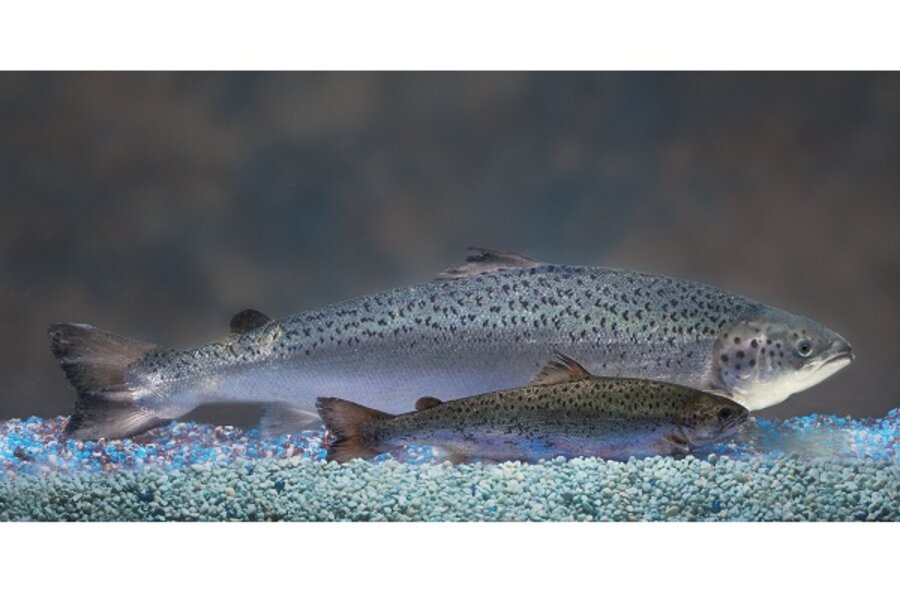Genetically modified salmon not harmful, FDA says
Loading...
| WASHINGTON
Federal health regulators say a genetically modified salmon that grows twice as fast as normal is unlikely to harm the environment, clearing the way for the first approval of a scientifically engineered animal for human consumption.
The Food and Drug Administration on Friday released its environmental assessment of the AquaAdvantage salmon, a faster-growing fish which has been subject to a contentious, years long debate at the agency. The document concludes that the fish "will not have any significant impacts on the quality of the human environment of the United States." Regulators also said that the fish is unlikely to harm populations of natural salmon, a key concern for environmental activists.
The FDA will take comments from the public on its report for 60 days before making it final.
The FDA said more than two years ago that the fish appears to be safe to eat, but the agency had taken no public action since then. Executives for the company behind the fish, Maynard, Mass.-based Aquabounty, speculated that the government was delaying action on their application due to push-back from groups who oppose genetically modified food animals.
Experts view the release of the environmental report as the final step before approval.
"We are encouraged that the environmental assessment is being released and hope the government continues the science-based regulatory process," AquaBounty said in a statement.
If FDA regulators clear the salmon, as expected, it would be the first genetically altered animal approved for food anywhere in the world.
Critics call the modified salmon a "frankenfish." They worry that it could cause human allergies and the eventual decimation of the natural salmon population if it escapes and breeds in the wild. Others believe breeding engineered animals is an ethical issue.
AquaBounty has maintained that the fish is safe and that there are several safeguards against environmental problems. The fish would be bred female and sterile, though a very small percentage might still be able to breed. The company said the potential for escape is low. The FDA backed these assertions in documents released in 2010.
Since its founding in 1991, Aquabounty has burned through more than $67 million developing the fast-growing fish. According to its midyear financial report, the company had less than $1.5 million in cash and stock left. It has no other products in development.
Genetically engineered — or GE — animals are not clones, which the FDA has already said are safe to eat. Clones are copies of an animal. In GE animals, the DNA has been altered to produce a desirable trait.
The AquaAdvantage salmon has an added growth hormone from the Pacific Chinooksalmon that allows the fish to produce growth hormone all year long. The engineers were able to keep the hormone active by using another gene from an eel-like fish called an ocean pout that acts like an "on" switch for the hormone. Typical Atlantic salmon produce the growth hormone for only part of the year.
It is still unclear whether the public will have an appetite for the fish if it is approved. Genetic engineering is already widely used for crops, but the government until now has not considered allowing the consumption of modified animals. Although the potential benefits — and profits — are huge, many people have qualms about manipulating the genetic code of other living creatures.
If the salmon are eventually approved for sale, consumers may not even know they are eating them. According to federal guidelines, the fish would not be labeled as genetically modified if the agency decides it has the same material makeup as conventional salmon. AquaBounty says that genetically modified salmon have the same flavor, texture, color and odor as the conventional fish, and the FDA so far has not shown any signs of disagreeing.
Wenonah Hauter, director of the advocacy group Food and Water Watch, said forgoing labeling not only ignores consumers' rights to know what they are eating, but "is simply bad for business, as many will avoid purchasing any salmon for fear it is genetically engineered."
Hauter urged members of Congress to block the impending approval of the fish. Congressional opposition to the engineered fish has so far been led by members of the Alaska delegation, who see the modified salmon as a threat to the state's wild salmonindustry.
Sen. Lisa Murkowski, R-Alaska, said Friday she is working to convince fellow senators that approval for the fish should be stopped.
"This is especially troubling as the agency is ignoring the opposition by salmon and fishing groups, as well as more than 300 environmental, consumer and health organizations," she said of the preliminary approval.







